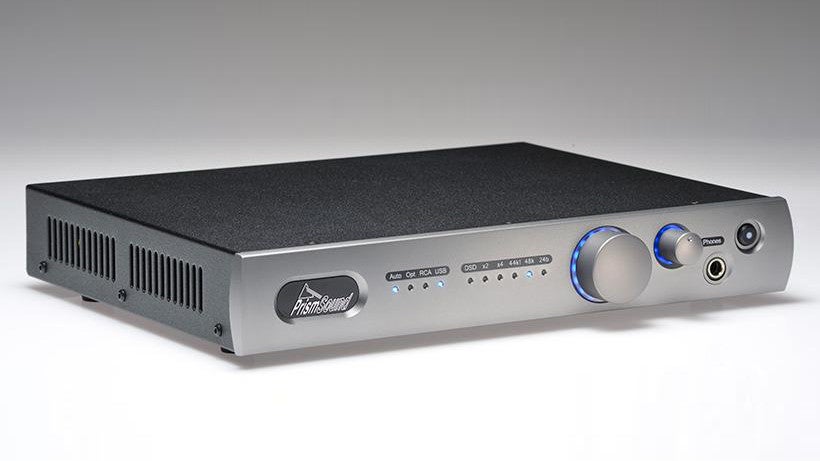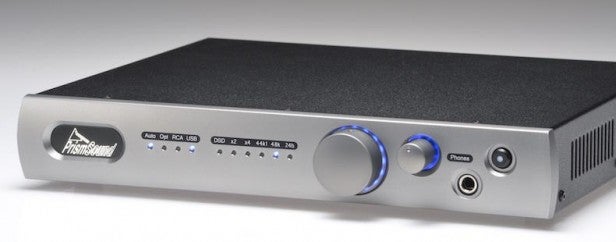Prism Sound Callia Review
Prism Sound Callia
A headphone amp that struggles to justify its high price

Verdict
Pros
- Dynamic sound with good timing
- Solid build
Cons
- Looks cheaper than it is
- Lack of mid-range clarity
Key Specifications
- Review Price: £1495.00
- S/PDIF optical, coaxial digital, USB inputs
- RCA phono and XLR balanced outputs
- 6.3mm headphones socket
- Hi-Res Audio playback up to 384kHz, DSD64/128
- 285 x 242 x 50mm, 2.1kg
What is the Prism Sound Callia?
Prism Sound is renowned for its pro audio kit, and the Callia is the company’s first foray into the home hi-fi market. It’s a DAC headphone amp and digital pre-amp that’s aiming to mix with the very best.
Related: Best USB Headphone Amps

Prism Sound Callia – Design and Features
The Callia is a heavy, well-built beast – there’s no doubt about that. It’s heftier than it looks, with a thick metal fascia.
Its styling, however, reminds me of Arcam separates from the 1990s, or something you might have picked up in Maplin to make up for your CRT TV having only one Scart. This isn’t the stuff of which high-end hi-fi legends are made.
Still, it has most of the accoutrements you could hope for. The front panel has a 6.3mm headphones socket with a dedicated volume knob, plus a main volume control for line outputs, a source-selector switch, and an array of LEDs to indicate the source and the bit-rate of the files you’re playing.
Around the rear are inputs for S/PDIF optical, coaxial digital and USB, as well as RCA phono and balanced XLR line outputs.
![]()
Thanks to the latter and that dedicated main volume knob, the Callia can double as a pre-amp in a full hi-fi system. However, the lack of a remote control or any analogue inputs makes it less than ideal for that duty.
Lastly, the back panel has a set of four small dip switches – for adjusting the Callia to suit different headphone sensitivities – and a standard kettle-plug power socket.
In the box, you also get one of the classiest USB keys I’ve ever seen. It’s only for the Windows drivers, but it’s a nice touch.
Prism Sound Callia – Sound Quality
I tested the Callia mostly using a pair of Grado Labs GS1000e over-ear headphones and a pair of Noble Audio Katana in-ears, and I also fed it to my main hi-fi system to test the DAC only. Source files from my Mac were a mixture of CD-quality FLAC, Hi-Res Audio FLAC and old 320kbps MP3s.
Starting off with something gentle and intimate in the form of Gregory Alan Isakov with the Colorado Symphony, the first thing that became apparent about the Callia was a lack of separation in the mid-range compared to the Chord Hugo, and a less extended treble. Individual instruments were nowhere near as easy to pick out in the enchanting “The Stable Song” as when listening to the Hugo. The Callia just doesn’t quite have the clarity, subtlety and precision with transients of the Hugo or larger Hugo TT.

What the Prism does do well is to keep things sounding exciting, thanks to plenty of attack and a great sense of timing. Moving on to Yeasayer’s Fragrant World, the waves of pulses and beats washed over with toe-tapping regularity.
Again, that mid-range smearing just stops the music from being truly immersive, however, and doesn’t make the most of headphones or speakers that are particularly capable of outstanding resolution. The Noble Audio Katana felt like they were on the leash through the Callia, and that certainly isn’t what you want when you’ve spent £1,700 on in-ear monitors.
On the plus side, poorer recordings weren’t so badly exposed – but I’d rather tap the full potential of the many glorious tracks than hinder them for the sake of papering over the duff ones.
Should I buy the Prism Sound Callia?
The Callia serves up an exciting listening experience, but it really can’t compete with the Chord Hugo. The Hugo sounds better in every department, and has the added benefits of portability and Bluetooth aptX streaming.
Related: Best Headphones
Verdict
A lack of mid-range clarity and a slightly naff design stop this DAC headphone amp from justifying its high price.


